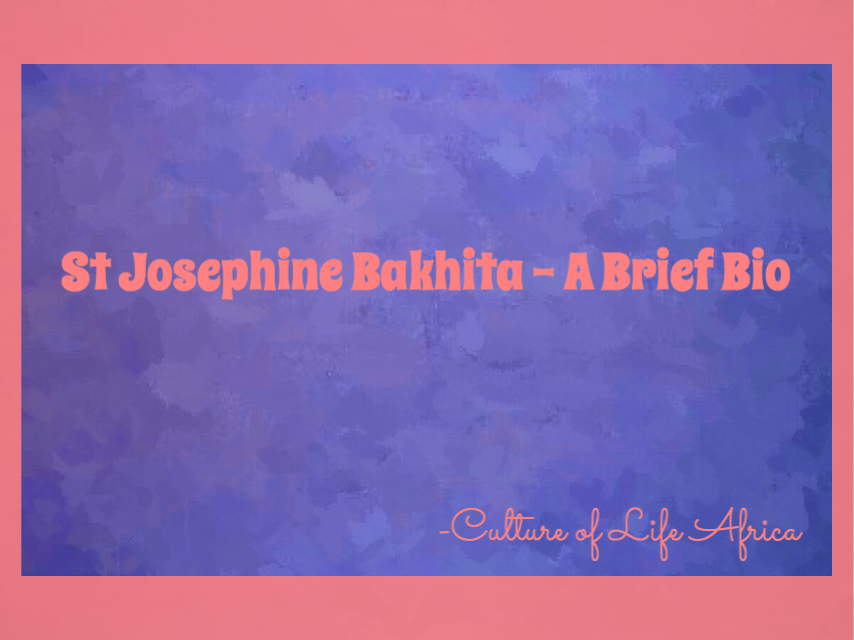St Josephine Bakhita was born around 1869—she herself did not know the precise date, to a wealthy Sudanese family—in Darfur in Sudan. At the age of nine, she was kidnapped by slave-traders and sold five times in the slave-markets of Sudan. She was given the name Bakhita by the slave traders which means “lucky” or “fortunate.”
​Eventually she found herself working as a slave for the mother and the wife of a general, and there she was flogged every day till she bled; as a result of this she bore 144 scars throughout her life. Her body was branded, beaten and cut. In her biography she tells one tragic story of torture:
“One day I unwittingly made a mistake that incensed the master’s son. He became furious, snatched me violently from my hiding place, and began to strike me ferociously with the lash and his feet. Finally he left me half dead, completely unconscious. Some slaves carried me away and lay me on a straw mat, where I remained for over a month. A woman skilled in this cruel art [tattooing] came to the general’s house…our mistress stood behind us, whip in hand. The woman had a dish of white flour, a dish of salt and a razor. When she had made her patterns; the woman took the razor and made incisions along the lines. Salt was poured into each of the wounds. My face was spared, but six patterns were designed on my breasts, and 60 more on my belly and arms. I thought I would die, especially when salt was poured in the wounds…it was by a miracle of God I didn’t die. He had destined me for better things.”
​Actually, St. Bakhita’s heroic virtue impressed Pope Benedict XVI so much that he wrote about her in his encyclical on Hope – Spe Salvi #3. He wrote of St. Bakhita:
​Finally, in 1882, she was bought by an Italian merchant for the Italian consul Callisto Legnani.
Here, after the terrifying “masters†who had owned her up to that point, Bakhita came to know a totally different kind of “masterâ€â€”in Venetian dialect, which she was now learning, she used the name “paron†for the living God, the God of Jesus Christ.
​Up to that time she had known only masters who despised and maltreated her, or at best considered her a useful slave. Now, however, she heard that there is a “paron†above all masters, the Lord of all lords, and that this Lord is good.
​She came to know that this Lord even knew her, that he had created her—that he actually loved her. She too was known and loved, and by none other than the supreme “Paronâ€, before whom all other masters are themselves no more than lowly servants.
​What is more, this master had himself accepted the destiny of being flogged and now he was waiting for her “at the Father’s right handâ€. Now she had “hope†—no longer simply the modest hope of finding masters who would be less cruel, but the great hope: “I am definitively loved and whatever happens to me—I am awaited by this Love. And so my life is good.â€
​Through the knowledge of this hope she was “redeemedâ€, no longer a slave, but a free child of God. She understood what Paul meant when he reminded the Ephesians that previously they were without hope because they were without God. Hence, when she was about to be taken back to Sudan, Bakhita refused; she did not wish to be separated again from her “Paronâ€.
​On January 9, 1890, as an adult convert, she was baptized, confirmed and received her First Holy Communion from the hands of the Patriarch of Venice. Of her Baptism, Bakhita said, ” I received the Sacrament of Baptism with such joy that only angels could describe…She took the name of Josephine as a symbol of her new life.
​She entered the Institute of Canossian Daughters of Charity in Venice, Italy in 1893, On December 8, 1896, in Verona, she took her final vows and for the next fifty years, besides her work in the sacristy and in the porter’s lodge at the convent, she made several journeys round Italy in order to promote the missions. In fact, after her biography was published in 1930, she became a noted and sought after speaker to raise funds for the missions. As Pope Benedict XVI said, “The liberation that she had received through her encounter with the God of Jesus Christ, she felt she had to extend, it had to be handed on to others, to the greatest possible number of people. The hope born in her which had “redeemed†her she could not keep to herself; this hope had to reach everybody.”
As a Canossian sister, Saint Josephine’s gentle presence, her warm, amiable voice, and her willingness to help with any menial task were a comfort to the poor and suffering people who came to the door of the Institute.
She died of natural causes on February 8, 1947 in Italy.
​She was beatified in 1992 and canonized on October 1, 2000, by Pope John Paul II, at which point he noted that “in St. Josephine Bakhita we find a shining advocate of genuine emancipation.”
Saint Josephine Bakhita is the first person to be canonized from the Subsaharan Africa and is the patron saint of Sudan.
​You can imagine the profound joy experienced by the African people when Pope John Paul II addressed the thousands of people gathered in Khartoum Sudan on February 10th 1993 during his apostolic visit, in his own words he said:
” Rejoice, all of Africa! Bakhita has come back to you: the daughter of the Sudan, sold into slavery as a living piece of merchandise, and yet still free: free with the freedom of the saints.”

